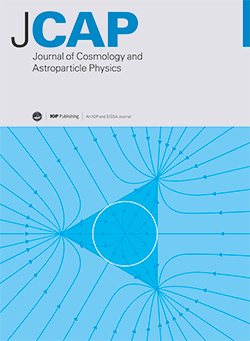Towards unveiling the large-scale nature of gravity with the wavelet scattering transform
IF 5.3
2区 物理与天体物理
Q1 ASTRONOMY & ASTROPHYSICS
Journal of Cosmology and Astroparticle Physics
Pub Date : 2024-11-28
DOI:10.1088/1475-7516/2024/11/061
引用次数: 0
Abstract
We present the first application of the Wavelet Scattering Transform (WST) in order to constrain the nature of gravity using the three-dimensional (3D) large-scale structure of the universe. Utilizing the Quijote-MG N-body simulations, we can reliably model the 3D matter overdensity field for the f(R) Hu-Sawicki modified gravity (MG) model down to kmax = 0.5 h/Mpc. Combining these simulations with the QuijoteνCDM collection, we then conduct a Fisher forecast of the marginalized constraints obtained on gravity using the WST coefficients and the matter power spectrum at redshift z=0. Our results demonstrate that the WST substantially improves upon the 1σ error obtained on the parameter that captures deviations from standard General Relativity (GR), yielding a tenfold improvement compared to the corresponding matter power spectrum result. At the same time, the WST also enhances the precision on the ΛCDM parameters and the sum of neutrino masses, by factors of 1.2-3.4 compared to the matter power spectrum, respectively. Despite the overall reduction in the WST performance when we focus on larger scales, it still provides a relatively 4.5× tighter 1σ error for the MG parameter at kmax =0.2 h/Mpc, highlighting its great sensitivity to the underlying gravity theory. This first proof-of-concept study reaffirms the constraining properties of the WST technique and paves the way for exciting future applications in order to perform precise large-scale tests of gravity with the new generation of cutting-edge cosmological data.用小波散射变换揭示重力的大尺度性质
我们提出了小波散射变换(WST)的第一个应用,以便利用宇宙的三维(3D)大尺度结构来约束重力的性质。利用Quijote-MG n -体模拟,我们可以可靠地模拟f(R) Hu-Sawicki修正重力(MG)模型的三维物质过密度场,其kmax = 0.5 h/Mpc。将这些模拟与QuijoteνCDM收集相结合,然后我们使用WST系数和红移z=0处的物质功率谱对重力得到的边缘约束进行Fisher预测。我们的研究结果表明,WST在捕获标准广义相对论(GR)偏差的参数上获得了1σ误差,与相应的物质功率谱结果相比,得到了10倍的改进。同时,WST还提高了ΛCDM参数和中微子质量总和的精度,与物质功率谱相比分别提高了1.2-3.4倍。尽管在更大尺度下WST的性能总体上有所下降,但在kmax =0.2 h/Mpc时,它仍然提供了相对4.5倍的1σ误差,突出了它对潜在重力理论的高度敏感性。这项首次概念验证研究重申了WST技术的约束特性,并为激动人心的未来应用铺平了道路,以便用新一代尖端的宇宙学数据进行精确的大规模重力测试。
本文章由计算机程序翻译,如有差异,请以英文原文为准。
求助全文
约1分钟内获得全文
求助全文
来源期刊

Journal of Cosmology and Astroparticle Physics
地学天文-天文与天体物理
CiteScore
10.20
自引率
23.40%
发文量
632
审稿时长
1 months
期刊介绍:
Journal of Cosmology and Astroparticle Physics (JCAP) encompasses theoretical, observational and experimental areas as well as computation and simulation. The journal covers the latest developments in the theory of all fundamental interactions and their cosmological implications (e.g. M-theory and cosmology, brane cosmology). JCAP''s coverage also includes topics such as formation, dynamics and clustering of galaxies, pre-galactic star formation, x-ray astronomy, radio astronomy, gravitational lensing, active galactic nuclei, intergalactic and interstellar matter.
 求助内容:
求助内容: 应助结果提醒方式:
应助结果提醒方式:


